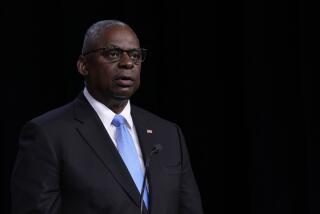THE TRAGEDY OF FLIGHT 655 : Navy Team Arrives in Gulf to Probe Downing of Airbus
- Share via
DUBAI, United Arab Emirates — A high-level U.S. Navy team arrived in the Persian Gulf on Tuesday to investigate the circumstances of the shooting down of an Iranian airliner, even as Tehran toned down its anti-American rhetoric in an apparent effort to reap full propaganda benefits from the tragedy.
In remarks carried by Iran’s official news agency, the country’s leader, the Ayatollah Ruhollah Khomeini, cautioned those calling the loudest for revenge. He told them to support the Speaker of Parliament, Hashemi Rafsanjani, whose comments have been conspicuously low-key by Iranian standards.
In a speech to Parliament broadcast by Tehran Radio, Rafsanjani called the U.S. Navy missile attack on the Iran Air jetliner “an unprecedented disaster in contemporary history.”
Rafsanjani said he reserved the right to avenge the action, but he cautioned against taking precipitous action.
“Maybe today they want a clumsy move to be made somewhere in the world so that they can take the propaganda pressure off America,” he said, apparently referring to other Western countries as well as the United States. “We should let this crime be known to everyone in the world and be discussed and be studied.”
Shortly after Rafsanjani spoke out, the Navy team headed by Rear Adm. William M. Fogarty flew into Bahrain, 300 miles northwest of Dubai, where the Navy’s Persian Gulf fleet is headquartered.
According to Pentagon officials, the team will have 15 days to determine how and why the cruiser Vincennes came to shoot down the A-300 Airbus, killing all 290 people on board.
No clear evidence emerged here Tuesday to clarify two of the most controversial aspects of the incident, which have become the focus of speculation:
-- Why the Vincennes tracked the Airbus as descending at a time when the plane was barely 8 minutes into its flight and had just been cleared to climb from 7,500 feet to 14,000 feet.
-- Why the Airbus was not properly identified on a route where there are only five commercially scheduled flights a week.
Sources familiar with the rhythm of the half-hour flight between Dubai and the Iranian port city of Bandar Abbas insisted that the plane should have been climbing in the early phase of its flight. But the aircraft was said to be outside the jurisdiction of United Arab Emirates traffic controllers when it was hit and so was not being observed.
A source here familiar with Iran Air operations noted that flight times on the Bandar Abbas-Dubai route are notoriously erratic, mainly because recently imposed and arduous pre-departure formalities in Bandar Abbas tend to cause delays. Sunday’s ill-fated flight was about 90 minutes late.
Iranian authorities said that about 200 bodies had been recovered from the crash site and taken to a morgue in Bandar Abbas. About 40 bodies were still to be identified.
Flights between the two cities remained suspended Tuesday, leaving hundreds of Iranian travelers and many relatives of victims stranded in Dubai. An Iranian air force Boeing 747 transport plane was on the ground at Dubai International Airport and was expected to transport most of those trying to reach Bandar Abbas.
Many of the city’s hotels have been deluged with long-distance telephone requests for information about relatives either stranded or believed to be on board the downed Airbus.
Visa Rules Relaxed
Joseph Antoune, guest relations manager at the Excelsior Hotel, said he had telexed copies of his hotel register to Iran Air in Tehran and Kuwait Airlines in Kuwait to ease telephone congestion.
To focus international attention on the incident, Iranian authorities have relaxed their normally stringent visa requirements for Western journalists and permitted them to travel to the country briefly in order to observe memorial services and, most likely, the funeral for the victims. No formal announcement has been made, but the funeral is expected to be held later this week in Bandar Abbas.
Iran’s senior representative to the United Nations in Geneva, Sirous Nasseri, also used restrained language, calling on the United States to pay compensation but stopping short of demanding violent counterattacks.
“Let public opinion and political activity run their course,” Nasseri said.
The more measured rhetoric from senior Iranian figures, along with the effort to swing global public opinion behind them, seemed to be in line with recent efforts by Iran to improve its relations with other countries.
Rafsanjani Critical
Rafsanjani, who not long ago took over as armed forces commander after a series of Iranian military reverses in the country’s nearly eight-year-old war with Iraq, recently criticized his government’s strident foreign policy. He said it provided no tangible benefit and left Iran isolated politically.
Iran recently re-established diplomatic relations with France and has signaled an interest in breathing life into its long-dormant relations with Britain.
Editorial opinion in leading Persian Gulf newspapers expressed more sorrow than outrage over the airliner incident. The Gulf News, published here, called for a U.N.-led investigation to fix the blame, and the Emirates Times of Abu Dhabi noted “the sad fact that those innocents . . . were the new victims” of the Iran-Iraq War.
More to Read
Sign up for Essential California
The most important California stories and recommendations in your inbox every morning.
You may occasionally receive promotional content from the Los Angeles Times.













